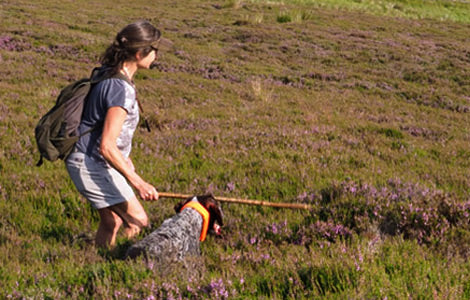There is a lot of emotional debate about grouse shooting at the moment. Indeed there is more than ever. As I work my pointers on Scottish grouse moors every year, counting pairs in the spring and broods in July/August, I can simply say that a managed grouse moor is a beautiful place with an enormously rich variety of flora and fauna. I have a MSc in plant biology and have a lifelong interest in ecology, hence I have some insight and understanding.
Like or loath grouse shooting, the unavoidable fact is that if you do not burn heather and manage predators, there will be very little life on the moor as the heather will grow rank, providing very poor habitat for our important waders and red grouse. The insect life in the muir-burnt vegetation is fantastic and it provides a very important food source for all birds.
In addition, if you do not reduce the density of two very important predators, the fox and the carrion crow, all your ground nesting birds are under threat.

This summer I spent three 10-hour days on a fantastic estate in the Angus Glens, counting grouse broods on three different beats on the estate. On each beat I spent time with the gamekeeper responsible for that area and it is absolutely amazing the amount of knowledge they have of grouse moor ecology and of everything that goes on in their own area.
On one of the beats I heard the curlew and asked how they had got on this spring. The gamekeeper’s face lit up and he told me about all the curlew nests, oystercatcher nests and lapwing nests he had been following during the spring. Sitting out waiting for a fox at 3am gives a unique opportunity to watch what is going on. On this beat there was a large wetland area supporting the waders and my companion told me about them all getting their chicks on the wing. The snipe was plentiful too.
All of these ground nesting birds are seriously struggling to survive on farmland where habitat loss and predator problems limit their existence. On a well-managed grouse moor they get a decent chance as the habitat is much more favourable and their predators are kept under control.
During my three days on this estate I never saw one crow. Instead, I saw pheasant chicks even though this estate does not release pheasants. I found a beautiful snipe chick at the top of the hill too. My dog went on point and a snipe got up. On inspection I could see one of the chicks.

On the wall of the cottage, where I lived for the three days, was a nest of a spotted fly catcher. The nest was sitting blatantly obvious to any crow watching and would have been destroyed – if there had been a crow.

Where I live in my own house in rural Aberdeenshire, there are far too many crows. They love eggs and they sit and watch where other birds nest so they can go and raid the whole lot.
The well-managed grouse moor was such a haven for wild birds. I have never seen such richness. It does take six full time gamekeepers at a substantial cost, but what a fantastic result. And yes, I also saw merlin, peregrine, golden eagle, a short-eared owl and a kestrel. Fabulous.
Who pays?
Thank goodness for managed grouse moors and for the people who are lucky enough to have the financial means to pump money in to the estates, their management, their infrastructure and the buildings.
From an economical point of view the number of jobs created around grouse and stalking estates are extremely important in areas where there would otherwise be very little employment opportunities.
These areas of Scotland would otherwise struggle to support themselves and we should welcome the investments from around the world, especially when the money is spent so well to support this fragile ecology.
The Grouse Numbers
The cold rain in June has wiped out many grouse chicks in Scotland. I have been counting on many moors and it looks, from reports too, that the damage from the weather was worse in the middle and west than in the East. Hence, we did find a good number of healthy broods in the Angus Glens, but even so, it varies from estate to estate and even from one hill to the next as the exact exposure makes a bit difference.

The Dog Work
My young dog, Pontus, has had to run a lot to find grouse on many estates this year, but at least he got a tremendous opportunity to get some more finds here. It was fantastic to see him handling the wind and the birds with more and more expertise. He is now three years old and looks like a proper working HPR dog.
About Luise
Passionate about ecology and the great Scottish outdoors, Luise is our ethical hunting expert and the founder & MD of Tuffies – a unique dog bed making business based in Aberdeenshire.
SHOP GAMEKEEPERS & BEATING CLOTHING

